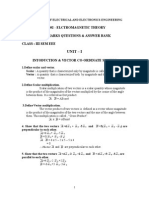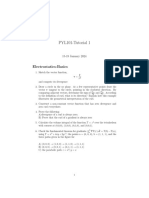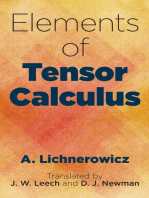The Curl of A Vector Field
The Curl of A Vector Field
Uploaded by
Manoj1508AravindCopyright:
Available Formats
The Curl of A Vector Field
The Curl of A Vector Field
Uploaded by
Manoj1508AravindOriginal Description:
Original Title
Copyright
Available Formats
Share this document
Did you find this document useful?
Is this content inappropriate?
Copyright:
Available Formats
The Curl of A Vector Field
The Curl of A Vector Field
Uploaded by
Manoj1508AravindCopyright:
Available Formats
9/16/2005
The Curl of a Vector Field.doc
1/7
The Curl of a Vector Field
Say xA ( r ) = B ( r ) . The mathematical definition of Curl is given
as:
Bi ( r ) = lim
s 0
vC A (r ) d A
i
si
This rather complex equation requires some explanation !
* Bi ( r ) is the scalar component of vector B ( r ) in the direction
defined by unit vector ai (e.g., ax , a , a ).
* The small surface si is centered at point r , and oriented
such that it is normal to unit vector ai .
* The contour Ci is the closed contour that surrounds surface
si .
Ci
ai
r
Jim Stiles
The Univ. of Kansas
si
Dept. of EECS
9/16/2005
The Curl of a Vector Field.doc
2/7
Note that this derivation must be completed for each of the
three orthonormal base vectors in order to completely define
B ( r ) = xA ( r ) .
Q: What does curl tell us ?
A: Curl is a measurement of the circulation of vector
field A ( r ) around point r .
If a component of vector field A ( r ) is pointing in the direction
d A at every point on contour Ci (i.e., tangential to the contour).
Then the line integral, and thus the curl, will be positive.
If, however, a component of vector field A ( r ) points in the
opposite direction (-d A ) at every point on the contour, the curl
at point r will be negative.
Bi < 0
Bi > 0
Likewise, these vector fields will result in a curl with zero value
at point r :
Jim Stiles
The Univ. of Kansas
Dept. of EECS
9/16/2005
The Curl of a Vector Field.doc
3/7
Bi = 0
Bi = 0
* Generally, the curl of a vector field result is in another
vector field whose magnitude is positive in some regions of
space, negative in other regions, and zero elsewhere.
* For most physical problems, the curl of a vector field
provides another vector field that indicates rotational sources
(i.e., paddle wheels ) of the original vector field.
For example, consider this vector field A(r ) :
4
x
-2
-4
-4
Jim Stiles
-2
The Univ. of Kansas
Dept. of EECS
9/16/2005
The Curl of a Vector Field.doc
4/7
If we take the curl of A(r ) , we get a vector field which points
in the direction az at all points (x,y). The scalar component of
this resulting vector field (i.e., Bz( r )) is:
4
0.75
-2
0.5
Ax Hx,y L
0.25
2
0
-4
-4
0
y
-4
-2
0
x
-2
-2
0
x
-4
4
The relationship between the original vector field A(r ) and its
resulting curl perhaps is best shown when plotting both
together:
4
-2
-4
-4
Jim Stiles
-2
0
x
The Univ. of Kansas
Dept. of EECS
9/16/2005
The Curl of a Vector Field.doc
5/7
Note this scalar component is largest in the region near point
x=-1, y=1, indicating a rotational source in this region. This is
likewise apparent from the original plot of vector field A(r ) .
Consider now another vector field:
4
-2
-4
-4
-2
Although at first this vector field appears to exhibit no
rotation, it in fact has a non-zero curl at every point
( B(r ) = 4.0 az ) ! Again, the direction of the resulting field is in
the direction az . We plot therefore the scalar component in
this direction (i.e., Bz (r ) ):
4
2
-2
-4
8
6
Ax Hx,y L
4
2
-2
0
-4
-2
-4
-4
-2
Jim Stiles
2
4
The Univ. of Kansas
Dept. of EECS
9/16/2005
The Curl of a Vector Field.doc
6/7
We might encounter a more complex vector field, such as:
4
-2
-4
-4
-2
If we take the curl of this vector field, the resulting vector
field will again point in the direction az at every point (i.e.,
Bx (r ) = By (r ) = 0 ). Plotting therefore the scalar component of
the resulting vector field (i.e., Bz (r ) ), we get:
1
4
Ax Hx,y L
0
2
-1
-2
-4
0
y
-2
-2
-4
x
-4
-4
-2
0
x
Note these plots indicate that there are two regions of large
counter clockwise rotation in the original vector field, and one
region of large clockwise rotation.
Jim Stiles
The Univ. of Kansas
Dept. of EECS
9/16/2005
The Curl of a Vector Field.doc
7/7
-2
-4
-4
-2
0
x
Finally, consider these vector fields:
4
-2
-2
-4
-4
-4
-2
-4
-2
The curl of these vector fields is zero at all points. It is
apparent that there is no rotation in either of these vector
fields!
Jim Stiles
The Univ. of Kansas
Dept. of EECS
You might also like
- 2009 Weapons FileDocument821 pages2009 Weapons Fileanon_56440062692% (25)
- HW1 A SolutionsDocument5 pagesHW1 A SolutionsAli Abbas SheriffNo ratings yet
- Module 2 - Classic Theories of Economic Growth and Development PPT - PDF - 2Document44 pagesModule 2 - Classic Theories of Economic Growth and Development PPT - PDF - 2Alyssa Alejandro50% (2)
- Cast Models and Dies2017Document61 pagesCast Models and Dies2017Ines MüllerNo ratings yet
- Faw FormulaeDocument7 pagesFaw Formulaeespaderarosario1007No ratings yet
- The Solenoidal Vector FieldDocument4 pagesThe Solenoidal Vector Fieldilg1No ratings yet
- WS 08.3 Volumes EDocument11 pagesWS 08.3 Volumes EPeter Aguirre KlugeNo ratings yet
- Iit-Jam Mathematical PhysicsDocument10 pagesIit-Jam Mathematical PhysicsVenugopal Reddyvari100% (1)
- Tutorial 1Document3 pagesTutorial 1Pravat Kumar SahooNo ratings yet
- Chapter 2 Geometry of CrystalsDocument56 pagesChapter 2 Geometry of CrystalssfdafNo ratings yet
- MC-Tarea 1Document3 pagesMC-Tarea 1Mosso MartinNo ratings yet
- EM PrerequisitesDocument47 pagesEM PrerequisitesBRUNDA H MNo ratings yet
- Electromagnetic TheoryDocument38 pagesElectromagnetic TheoryNaga LakshmaiahNo ratings yet
- Week 9: Surfaces and Surface IntegralsDocument8 pagesWeek 9: Surfaces and Surface IntegralsTeresa Villena GonzálezNo ratings yet
- PYL101 Tutorial2Document3 pagesPYL101 Tutorial2Sanskriti SuryawanshiNo ratings yet
- Chapter-2 Emf by SadiqueDocument35 pagesChapter-2 Emf by SadiqueAnonymous 4bUl7jzGqNo ratings yet
- Electromagnetic Field TheoryDocument73 pagesElectromagnetic Field Theoryajas777BNo ratings yet
- Electromagnetic TheoryDocument108 pagesElectromagnetic Theorytomica06031969No ratings yet
- Incircles and Excircles - Brilliant Math & Science WikiDocument5 pagesIncircles and Excircles - Brilliant Math & Science Wikichaparral2008No ratings yet
- Vector Calculus 2Document21 pagesVector Calculus 2Hergene FanerNo ratings yet
- Objectives: Review Vectors, Dot Products, Cross Products, RelatedDocument12 pagesObjectives: Review Vectors, Dot Products, Cross Products, Relatedbstrong1218No ratings yet
- Physics 1116 Problem Set 1Document3 pagesPhysics 1116 Problem Set 1Somrita BanerjeeNo ratings yet
- 7-3 The Biot-Savart Law and The Magnetic Vector Potential - PDFDocument21 pages7-3 The Biot-Savart Law and The Magnetic Vector Potential - PDFursml12No ratings yet
- Em1 PDFDocument73 pagesEm1 PDFFernando SierraNo ratings yet
- Cylindrically Orthotropic Circular Plates With Large Deflections 1)Document11 pagesCylindrically Orthotropic Circular Plates With Large Deflections 1)yasameenNo ratings yet
- Regge Calculus in The Canonical Form: Budker Institute of Nuclear Physics, Novosibirsk 630090, RussiaDocument24 pagesRegge Calculus in The Canonical Form: Budker Institute of Nuclear Physics, Novosibirsk 630090, RussiacrocoaliNo ratings yet
- ps1 2024Document2 pagesps1 2024Sai Rojitha mallaNo ratings yet
- Hamel' S Theorem: A. W. MarrisDocument21 pagesHamel' S Theorem: A. W. MarrisDante FreidzonNo ratings yet
- ECE Department ABES Engineering College GhaziabadDocument62 pagesECE Department ABES Engineering College GhaziabadAmit GargNo ratings yet
- Ps 1Document2 pagesPs 1Chashan DeepNo ratings yet
- Differetial GeometryDocument10 pagesDifferetial GeometrySunilKumarNo ratings yet
- ABcalc APexam Probs Area Volume0910Document18 pagesABcalc APexam Probs Area Volume0910joseph ronggurNo ratings yet
- 2 MarksDocument16 pages2 Marksabiij0511No ratings yet
- 6 Electromagnetic Fields and WavesDocument25 pages6 Electromagnetic Fields and WavesGuruhEkoHarySaputroNo ratings yet
- Tutorial 2Document3 pagesTutorial 2Rainesius DohlingNo ratings yet
- Function, Which Specifies A Particular Quantity Everywhere in The Region Two TypesDocument33 pagesFunction, Which Specifies A Particular Quantity Everywhere in The Region Two TypesRonan RojasNo ratings yet
- Ch15 (Part I)Document46 pagesCh15 (Part I)ujjwal2110No ratings yet
- Nptel 1Document57 pagesNptel 1Lanku J GowdaNo ratings yet
- Electro Magnetic Theory PPT 1Document76 pagesElectro Magnetic Theory PPT 1JayaNo ratings yet
- Electromagnetic Field Theory: A Problem Solving ApproachDocument11 pagesElectromagnetic Field Theory: A Problem Solving ApproachahmdNo ratings yet
- Tutorial 1Document3 pagesTutorial 1prasitmazumderNo ratings yet
- EMT Unit 1 QN BankDocument21 pagesEMT Unit 1 QN BankKeerthana SahadevanNo ratings yet
- Naval GeometryDocument7 pagesNaval GeometryLucas TarcioNo ratings yet
- Building Materials Notes-2Document37 pagesBuilding Materials Notes-2LESLIE JANE MERCADONo ratings yet
- B. Bertotti Et (Eds.), General Relativity and Gravitation, 5-26. by D. Reidel Publishing CompanyDocument22 pagesB. Bertotti Et (Eds.), General Relativity and Gravitation, 5-26. by D. Reidel Publishing CompanyShubham SinghNo ratings yet
- Surfaces With Curvature-CayleyDocument29 pagesSurfaces With Curvature-CayleySrinivasaNo ratings yet
- Alg Exercises 3Document3 pagesAlg Exercises 3Cayuss Andrei MihăițoaiaNo ratings yet
- Calculus Surfaces 1Document16 pagesCalculus Surfaces 1Krish Parikh100% (1)
- Volumes by Integration1 TRIGONOMETRYDocument8 pagesVolumes by Integration1 TRIGONOMETRYChristopherOropelNo ratings yet
- To Differential Geometry: Robert BartnikDocument40 pagesTo Differential Geometry: Robert BartnikDhruv BhardwajNo ratings yet
- Linear Independence, Basis and Dimension: Dr. A V PrajeeshDocument10 pagesLinear Independence, Basis and Dimension: Dr. A V PrajeeshADLURI SRIKARNo ratings yet
- CalcExercisesCh6 Exercise To IntegralDocument6 pagesCalcExercisesCh6 Exercise To IntegralMd Ibrahim MollaNo ratings yet
- EMT - 2A - Cylindrical CoordinatesDocument59 pagesEMT - 2A - Cylindrical Coordinates5610Umar IqbalNo ratings yet
- Theorem of Gauss, Green, StokesDocument5 pagesTheorem of Gauss, Green, StokesДмитрий ГрадовNo ratings yet
- Characteristics of Radar Cross Section With Different ObjectsDocument12 pagesCharacteristics of Radar Cross Section With Different ObjectsanilNo ratings yet
- PHYS2050 2010 2 Curl StuffDocument11 pagesPHYS2050 2010 2 Curl StuffEkky CecilNo ratings yet
- 082187571X GeometriesDocument160 pages082187571X GeometriescarlosNo ratings yet
- Medial Axis: Exploring the Core of Computer Vision: Unveiling the Medial AxisFrom EverandMedial Axis: Exploring the Core of Computer Vision: Unveiling the Medial AxisNo ratings yet
- Reaction Paper IDocument5 pagesReaction Paper IAmelia C. Bibera100% (1)
- Unit-2 Capital and Money MarketDocument10 pagesUnit-2 Capital and Money MarketDivyasree DsNo ratings yet
- MIL 4th Quarter ExamDocument3 pagesMIL 4th Quarter Examgrace alvarezNo ratings yet
- SAB CHCHCS001 Provide Home and Community Support ServicesDocument58 pagesSAB CHCHCS001 Provide Home and Community Support Servicespoonam mahatNo ratings yet
- Class 11 English Sample PaperDocument23 pagesClass 11 English Sample PaperUrval Jain67% (3)
- Action Research ReportDocument2 pagesAction Research ReportmeghtNo ratings yet
- Period of AnarchyDocument4 pagesPeriod of AnarchyChaya SorirNo ratings yet
- Name of The Project: I. Basic InformationDocument4 pagesName of The Project: I. Basic InformationErullyn KimNo ratings yet
- Cad 3d in IsraelDocument22 pagesCad 3d in IsraelMihai Madalin SuicaNo ratings yet
- Spouses Roque Vs AguadoDocument3 pagesSpouses Roque Vs AguadoMary dela RosaNo ratings yet
- Multiinstrument: With Control and Protection Device For Genset Unit TYPE SPG-120/20Document2 pagesMultiinstrument: With Control and Protection Device For Genset Unit TYPE SPG-120/20Ya ŞamNo ratings yet
- Training Plan 10k Beginner v2Document4 pagesTraining Plan 10k Beginner v2BrooksRunning0% (1)
- Advanced CSS Drop Down Menu 2 - Expression Web Add-InDocument8 pagesAdvanced CSS Drop Down Menu 2 - Expression Web Add-InAhmad Rashed SalimiNo ratings yet
- Condensate Extraction Pump (CEP)Document12 pagesCondensate Extraction Pump (CEP)mudrijasm50% (2)
- Openocd LogDocument775 pagesOpenocd Lognoeth3rNo ratings yet
- Dakota State University College of Education Lesson Plan FormatDocument6 pagesDakota State University College of Education Lesson Plan Formatapi-568329686No ratings yet
- Abdelhay Et Al-2022-Water, Air, & Soil PollutionDocument18 pagesAbdelhay Et Al-2022-Water, Air, & Soil Pollutionomarmalkawi175No ratings yet
- Latex Mathmode (PDFDrive)Document150 pagesLatex Mathmode (PDFDrive)Ingeniero riveraNo ratings yet
- 2nd Grade Talking Stick Lesson PlanDocument2 pages2nd Grade Talking Stick Lesson Planapi-2382066030% (1)
- EVlink Home - EVH4S07N2Document2 pagesEVlink Home - EVH4S07N2Amzon JumardiNo ratings yet
- The Impact of Climate Change On Soils and On Their Water ManagementDocument12 pagesThe Impact of Climate Change On Soils and On Their Water ManagementVukasin MilcanovicNo ratings yet
- TV 2024Document12 pagesTV 2024sanskar jaiswalNo ratings yet
- Africa Grant Funding: Any African NationalDocument2 pagesAfrica Grant Funding: Any African NationalFampau CoulibalyNo ratings yet
- ERP ConceptsDocument27 pagesERP ConceptsLaxmi Pai100% (1)
- Analysis of Non-Productive Time (NPT) in Drilling Operations-A Case Study of The Ghadames BasinDocument10 pagesAnalysis of Non-Productive Time (NPT) in Drilling Operations-A Case Study of The Ghadames BasinAmr TohamyNo ratings yet
- 2 - Water and Aqueous Solutions: © 2013 W. H. Freeman and CompanyDocument60 pages2 - Water and Aqueous Solutions: © 2013 W. H. Freeman and CompanyMahdeeHaqueSyedNo ratings yet
- Astm A 607Document3 pagesAstm A 607Rosario BuonannoNo ratings yet

























































































